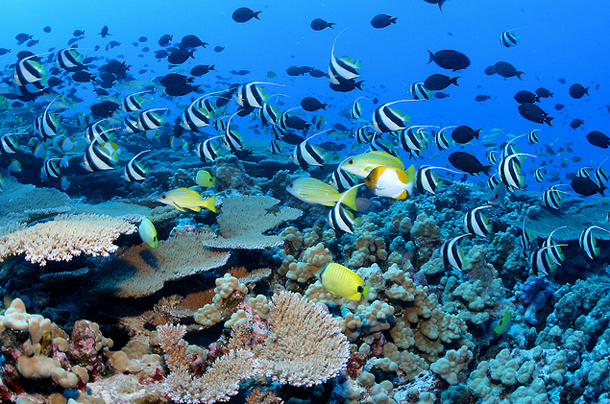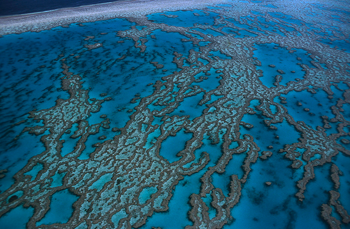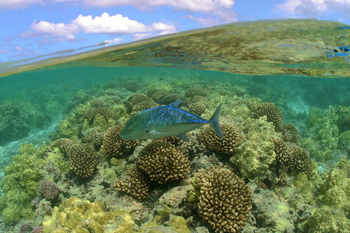Marine Reserves
Air Date: Week of August 3, 2012
 |
Divers flock to spots like the Great Barrier Reef, the Northern Hawaiian Islands, and the Phoenix Islands for their incredible biodiversity and picturesque reefs. Recently, national governments have recognized the importance of preserving these areas by implementing marine protection areas. Host Steve Curwood speaks with Phil Dearden, geography professor at the University of Victoria, about the state of the seas.
Transcript
CURWOOD: Now there’s a strange juxtaposition between protected islands and the offshore oilrigs that Bobby saw off the coast of Rio in Brazil. Around the globe, multi-national companies are increasingly drilling into the depths, and as the deepwater disaster in the Gulf of Mexico showed, those wells can threaten the environment.
Yet at the same time, the amount of ocean protected by national governments is also increasing. Philip Dearden studies these Marine Protected Areas. He’s Professor and Chair of the Department of Geography at the University of Victoria in British Colombia, and he joins us now. Welcome to Living on Earth, Professor.
DEARDEN: It's a pleasure to be here!
CURWOOD: So tell me about Marine Protected Areas, your area of research - how do they work?
DEARDEN: Well, essentially the same way as National Parks work in the terrestrial environment. We say these areas are set aside to protect environmental processes for the species therein and they take top priority. So, we don’t kill them, we don’t interrupt the processes. So in so doing, we increase the diversity and increase their numbers and we keep healthy ecosystems alive.
CURWOOD: Now you can put a fence around a National Park, but fish can go anywhere. What’s the advantage of having a special marine protected area?
DEARDEN: The advantage is for sedentary species are very clear. For fish that do a lot of movement, then you have to look at - do these fish need protection, and if so, in what particular areas. For example, you might set aside an MPA for them in an area where they would do their spawning aggregation, or something like that.
CURWOOD: So, Marine Protected Areas - especially good to protect the breeding areas for certain kinds of fish.
DEARDEN: That’s right.
CURWOOD: So, Bobby Bascomb did a story about some protected islands off of Brazil, and the limits only go a few feet from shore - I’m wondering - just how big do you have to have a Marine Protected Area in order for it to be effective as a conservation device?
DEARDEN: It’s just like the terrestrial environment. In general, larger areas are much more ecologically effective, so the larger the area, the better that it is. As well, you have a lot of edge effect on these marine protected areas. If you have people fishing around the outside and you’ve only got 30 feet protected, fish don’t have to swim very far to become unprotected.
So, 30 feet would be the smallest that I’ve ever heard of. Generally the science suggests that at least 30 percent of every marine habitat should be in a no-take zone, should be protected.
CURWOOD: So tell me, what’s your favorite Marine Protected Area around the planet?

Australia’s Great Barrier Reef (WWF Deutschland)
DEARDEN: Whoa! That’s a tough one. We spend a lot of time working in Thailand, and I’ve been undertaking studies there for almost 30 years. I still love the diving off the reefs there - there’s still wonderful coral to be seen, and quite a big abundance of fish. When I go to areas such as the Great Barrier Reef in Australia I’m also awed by just the scale of them and the efficiency of the protection in those kinds of areas.
CURWOOD: And how effective do you think that the Marine Protected Areas have been there off Thailand, have been off the Great Barrier Reef? How effective is this as a conservation measures?
DEARDEN: Well, the research is very strong that when you do establish a protected area in the ocean that the numbers of fish increases, the diversity increases, the size class of the fish increase. And along with that there are other components of the ecosystem that also increase in their overall abundance. And so they’ve been proven to be extremely effective, and some of the best results on that come again on the Great Barrier Reef and from monitoring that has been undertaken there.
CURWOOD: Professor Dearden, I understand that part of your work focuses on incentive-based conservation, please tell me a bit about that.
DEARDEN: Well, the way that most protected areas are protected is by national legislation and policy. And then we pay park guards to come and enforce those regulations and policies. But the optimal situation is when local people in fact, see it in their own best interest to protect the conservation values.
In terms of fishing, the research clearly shows that over 10-15 years time, generally fishing returns improve because you have a spill-over effect from the MPA into the local fishing areas, so there will be more fish to catch.
Other ones relate to transformation of the economy. We’ve particularly worked with how can you derive more income from ecotourism? And how can those incomes go to local villages and help replace more extractive fishing activities?

A Blue fin Trevally in Hawaii’s Papahānaumokuākea Marine National Monument. (US Fish and Wildlife Service)
CURWOOD: So, if I were to look at the oceans as a whole, what portion of it, what percentage of the oceans are marine areas around the world that are considered to be in protected zones?
DEARDEN: Well, now it's just over one percent of the ocean is considered to be protected. Again, what is protected, not all of those necessarily forbid fishing, for example. So in Canada, every Marine Protected Area is supposed to have a no-take zone. Under the Parks Canada Marine Protected Areas – there is only one established at the moment – and that no-take zone was three percent of the area.
So, only three percent of the entire protected area was actually protected from fishing. And, within that three percent, it still allowed aboriginal fishing. So when you get down to it - there are no areas that are set aside that are totally non-extractive.
CURWOOD: Dr. Phillip Dearden is professor and Chair of the Department of Geography at the University of Victoria, in British Columbia, thank you so much.
DEARDEN: OK, it's been a pleasure, thank you.
Links
Living on Earth wants to hear from you!
Living on Earth
62 Calef Highway, Suite 212
Lee, NH 03861
Telephone: 617-287-4121
E-mail: comments@loe.org
Newsletter [Click here]
Donate to Living on Earth!
Living on Earth is an independent media program and relies entirely on contributions from listeners and institutions supporting public service. Please donate now to preserve an independent environmental voice.
NewsletterLiving on Earth offers a weekly delivery of the show's rundown to your mailbox. Sign up for our newsletter today!
 Sailors For The Sea: Be the change you want to sea.
Sailors For The Sea: Be the change you want to sea.
 The Grantham Foundation for the Protection of the Environment: Committed to protecting and improving the health of the global environment.
The Grantham Foundation for the Protection of the Environment: Committed to protecting and improving the health of the global environment.
 Contribute to Living on Earth and receive, as our gift to you, an archival print of one of Mark Seth Lender's extraordinary wildlife photographs. Follow the link to see Mark's current collection of photographs.
Contribute to Living on Earth and receive, as our gift to you, an archival print of one of Mark Seth Lender's extraordinary wildlife photographs. Follow the link to see Mark's current collection of photographs.
 Buy a signed copy of Mark Seth Lender's book Smeagull the Seagull & support Living on Earth
Buy a signed copy of Mark Seth Lender's book Smeagull the Seagull & support Living on Earth

